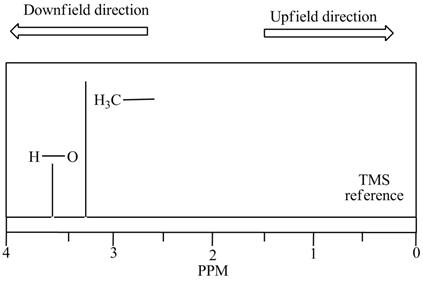
Concept explainers
The
two signals, one due to the
absorption. (b) Do the
(a)
Interpretation: The chemical shifts of the given absorptions are to be calculated.
Concept introduction: In NMR spectrum, peaks are known as resonances, lines or absorptions. On the horizontal axis, the position of absorption is generally referred to as chemical shift. The chemical shift of any absorption is calculated by the formula,
Answer to Problem 14.1P
The chemical shifts of the given absorptions are
Explanation of Solution
The observed chemical shift due to the
The observed chemical shift due to the
The operating frequency is
The conversion of
Therefore, the conversion of
Chemical shift
Chemical shift due to
The chemical shift of absorption is calculated by the formula,
Where,
Substitute the values of observed chemical shift and operating frequency in the above formula to calculate the chemical shift due to
Therefore, the chemical shift is
The conversion of
Therefore, the conversion of
Hence, the chemical shift is
Chemical shift due to
Substitute the values of observed chemical shift and operating frequency in the above formula to calculate the chemical shift due to
Therefore, the chemical shift is
The conversion of
Therefore, the conversion of
Hence, the chemical shift is
The chemical shifts of the given absorptions are
(b)
Interpretation: Whether the
Concept introduction: In NMR spectrum, peaks are known as resonances, lines or absorptions. On the horizontal axis, the position of absorption is generally referred to as chemical shift. The increasing order of chemical shift is plotted from right to left in NMR spectrum.
Answer to Problem 14.1P
The peak of
Explanation of Solution
The terms, upfield and downfield expresses the relative location of signals. The meaning of upfield is to the right and of downfield is to the left. The

Figure 1
Hence, the peak of
The peak of
Want to see more full solutions like this?
Chapter 14 Solutions
Organic Chemistry
Additional Science Textbook Solutions
General, Organic, and Biological Chemistry - 4th edition
Applications and Investigations in Earth Science (9th Edition)
HUMAN ANATOMY
Physical Science
Biology: Concepts and Investigations
- Need help with 14 and 15. 14. bromobenzene + (CHs),CuLi + THF / -78° followed by water quench is a. toluene else!! b. xylene c. cumene d. styrene e. something 15. When cumene + H,SO, / Na,Cr, 0,/water are mixed (refluxed) what is produced? a. 2-phenylpropanol phenol e. styrene b. benzoic acid c. no reaction!arrow_forwardWhich of the following orbitals intersect or overlap the x-axis in the standard cartesian coordinate system used? (Select ALL correct answers.) Group of answer choices px dxz dx2-y2 py dxy sarrow_forwardWhich of the following sets of elements is not a Dobereiner triad? (Choose the best answer.) Group of answer choices Li-Na-K Al-Ga-In Cr-Mo-W K-Rb-Csarrow_forward
- Don't used Ai solution and don't used hand raitingarrow_forwardDon't used hand raiting and don't used Ai solutionarrow_forwardGive the structure(s) of the product(s) the reaction below, and be sure to indicate any relative stereochemistry (you can assume that each of the Diels-Alder reactions will proceed with endo selectivity). Draw out relevant enantiomer(s) if they are expected to form. If no reaction is expected to occur under the indicated conditions, then write "no reaction" or NR, and explain why you would expect nothing to occur. If more than one product is formed, please indicate which one will be the major product or if they will be formed in equal amounts. In all cases, equimolar amounts of both components/reagents are present unless indicated otherwise I'm struggling to see how this reaction will go! I am wondering if it will cycle on itself but I'm not sure how I drew out a decagon but I'm a bit lostarrow_forward
- Give the structure(s) of the product(s) for the reactions below, and be sure to indicate any relative stereochemistry (you can assume that each of the Diels-Alder reactions will proceed with endo selectivity). Draw out relevant enantiomer(s) if they are expected to form. If no reaction is expected to occur under the indicated conditions, then write "no reaction" or NR, and explain why you would expect nothing to occur. If more than one product is formed, please indicate which one will be the major product or if they will be formed in equal amounts. In all cases, equimolar amounts of both components/reagents are present unless indicated otherwise .arrow_forwardCalculate the residence time of strontium (Sr2+) in the world ocean, given that the average concentration of strontium in the world’s rivers is approximately 0.87 µmol L-1 (5 pts).arrow_forwardA package contains 1.33lbs of ground round. If it contains 29% fat, how many grams of fat are in the ground? arrow_forward
- How is the resonance structure formed to make the following reaction product. Please hand draw the arrows showing how the electrons move to the correct position. Do not use an AI answer. Please draw it yourself or don't bother.arrow_forwardPart II Calculate λ max of the following compounds using wood ward- Fiecer rules a) b) c) d) e) OH OH dissolved in dioxane Br Br dissolved in methanol. NH₂ OCH 3 OHarrow_forward6. Match each of the lettered items in the column on the left with the most appropriate numbered item(s) in the column on the right. Some of the numbered items may be used more than once and some not at all. a. Z = 37 1. b. Mn 2. C. Pr element in period 5 and group 14 element in period 5 and group 15 d. S e. [Rn] 7s¹ f. d block metal 3. highest metallic character of all the elements 4. paramagnetic with 5 unpaired electrons 5. 4f36s2 6. isoelectronic with Ca²+ cation 7. an alkaline metal 8. an f-block elementarrow_forward

 Principles of Instrumental AnalysisChemistryISBN:9781305577213Author:Douglas A. Skoog, F. James Holler, Stanley R. CrouchPublisher:Cengage Learning
Principles of Instrumental AnalysisChemistryISBN:9781305577213Author:Douglas A. Skoog, F. James Holler, Stanley R. CrouchPublisher:Cengage Learning

